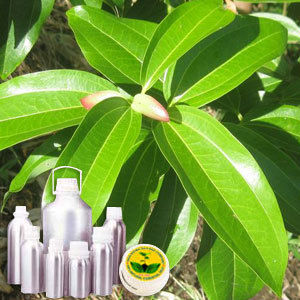Botonical Name | : | Cinnamomum Zeylanicum | |
CAS # | : | 8015-91-6 | |
Country of Origin | : | India & Sri Lanka | |
Color & Odor | : | Yellowish to brownish liquid with Spicy, warm cinnamon odour | |
Solubility | : | Insoluble in water, soluble in alcohol and oils | |
F.E.M.A. # | : | 2292 | |
Specific Gravity | : | 1.0390 – 1.0490 @ 20°C | |
Optical Rotation | : | -1.5° to +2.5° | |
Refractive Index | : | 1.5220 – 1.5350 @ 20°C | |
Flash Point | : | >100°C | |
Major Constituents | : | Eugenol, Linalool | |
Plant Part Used | : | Leaves | |
Extraction Method | : | Steam Distillation |
DESCRIPTION:
Cinnamon Leaf Oil is obtained from leaves of Cinnamomum verum (botanical name) plant via steam distillation process. The derived oil has golden brown colored appearance and it easily integrates with all sorts of citrus oils. CONSTITUENTS:
Eugenol, cinnamaldehyde, benzyl benzoate, linalol, Alpha Pinene, Alpha-Phellandrene.AROMATIC SUMMARY / NOTE / STRENGTH OF AROMA:
The middle note fragrance of Cinnamon Leaf Oil has spice like warm smell which is the combined aroma of cinnamon and clove. The herbaceous smell of this oil is not sweet although. BLENDS WITH:
Cinnamon Leaf Oil can be blended with essential oils of Rosemary, spice extracted oils like clove oil, thyme and lavender. COMMON NAMES:
The offered essential oil is known as cinnamon bark, cassia, Cinnamomum cassia and cinnamon oil. USES:
Cinnamon Leaf Oil is known for its anti septic, stimulating and antibiotic attributes. The astringent characteristics of this oil are used to treat injury. As suitable emmenagogue factor, it promotes menstrual flow. Its carminative properties are useful for curing flatulence. Its antispasmodic attributes provide relief from muscle spasm and it is also used to prevent growth of insects. 


































